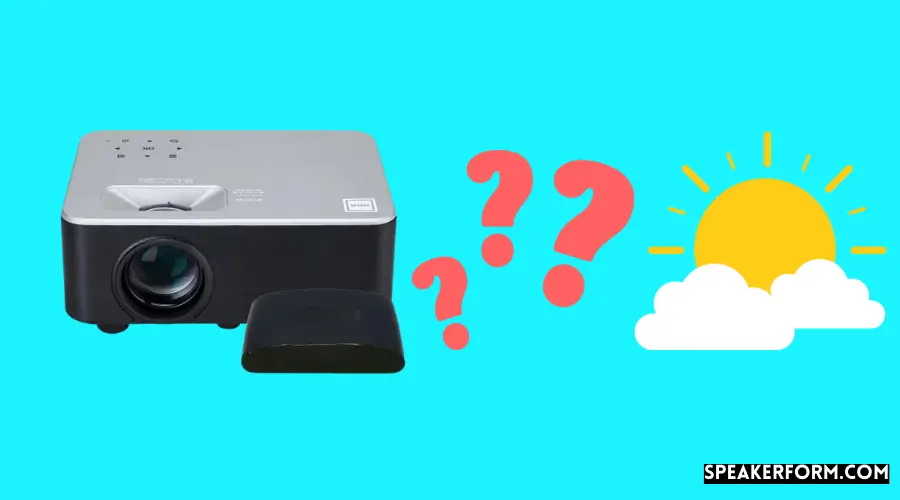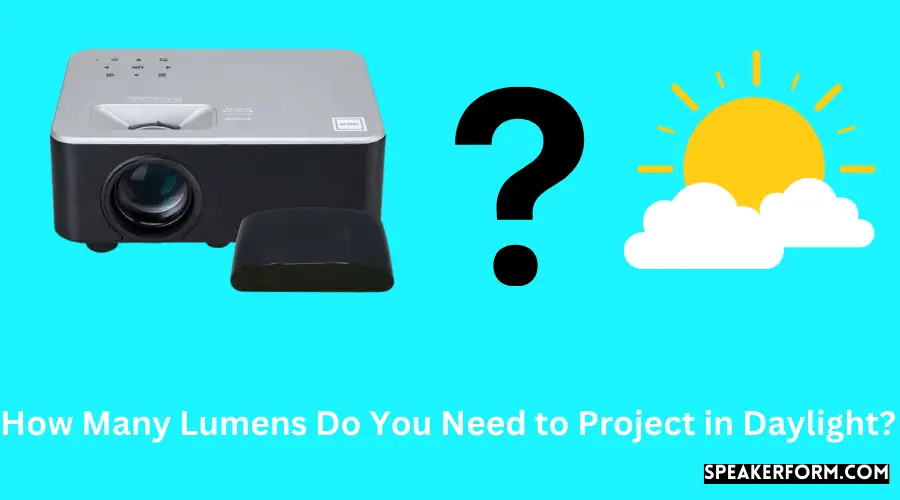In daylight, how many lumens must you project? You’ll need a projector bulb brightness of 2,500 lumens or greater to see your projected image clearly in the daytime, the brightest ambient light you’ll ever see. While 2,500 lumens is a reasonable starting point in bright environments, projectors should follow the “3,000 lumens and above” guideline instead. Remember, this is in a shaded area of your outdoor theater, not in full sunshine. Projecting in direct sunshine requires 120,000 lux of brightness, which no projector can provide.
The Importance of Brightness to Project in Daylight
When presenting images, videos, or user interfaces in broad daylight, there are many considerations to be made. Direct sunlight, on the other hand, will degrade the quality of any projector’s light. However, ambient light in a conference room or sunshine, in general, may be handled by utilizing the appropriate lumen count on your projector of choice.
Bear in mind that the critical element remains the overall brightness of the projector and perhaps the reflectivity of the screen you’re utilizing.
● Brightness in Lumens: Lumens or lux is a unit of measurement for the brightness of a light. The higher the lumen count of your projector bulb, the brighter the resultant light. Direct sunlight has a luminous intensity of 120,000 lux. Making a projector picture viewable in direct sunlight, on the other hand, when you’re having an outdoor movie marathon or anything similar in your backyard with a projector. Brighter your projector, the more vivid it will seem even when ambient light is present, sunshine, open curtains, or a conference room. To guarantee picture clarity, low-light projectors need complete darkness or muted lighting, as well as a reflecting screen.
● Consider The Application: The number of lumens required by your projector is determined by the purpose for which it is being used and the projector’s location. To be more precise, the purpose for which your projector is being used should determine the number of lumens it should contain, but 2,500 to 3,000 lumens or more is a reasonable minimum requirement for presentation projectors that will be exposed to ambient light. Certain games, especially horror games, need more illumination than others. Presentations may also benefit from the large swaths of white space on each slide. Additionally, the diagonal picture size may influence the number of lumens required.
● Typical Room Brightness Considerations: Ambient light levels may range from dim to strong depending on where you are. This is true for residential and commercial cinemas, as well as conference rooms with light fixtures on and outdoor movie theaters with projectors in the garden. As much as possible, you want a powerful projector to compensate for the stronger ambient light or sunshine, which seems to degrade the intensity of your projector’s picture. While the light from your projector remains constant, your eyes adapt to the quantity of light they perceive.
● Home or Commercial Cinemas to Drive-In Theaters: Lumens with a lower or weaker output should be utilized only in-home or commercial cinema situations. Projectors with a higher lumen output may be utilized in schools, conference halls, and boardrooms, among other places. There are also ultra-high lumen projectors available for use in daylight, But don’t get your hopes up; direct sunshine will always win. Even if you go to a drive-in movie theater in the afternoon or evening, you’ll still need some shade to view the projection image.
How Many Lumens Do You Need to Project in Daylight? What is a good lux for a projector?

Projecting movies or presentations in broad daylight requires far higher brightness levels than doing so in low light. Even though the brightness is just one factor to consider when purchasing a projector for many reasons, in this situation, the projector with the most lumens wins.
● Dark Cinema Rooms: To watch movies in dark rooms, you’ll need a projector from the 2010s or 2020s that puts out at least 1,000 lumens of light. You can utilize low-brightness projectors in low light if you have an extra-reflective screen. Still, newer projectors have greater brightness needs to keep up with increasingly high-resolution displays. When used in complete darkness, a high-resolution projector needs up to 1,000 lumens of brightness to guarantee that every pixel is visible and to meet the Ultra HD device’s crystal-clear clarity marketing claims.
● Brighter Rooms with The Lights On: What is the most effective projector for a room with plenty of natural light? A brightness count of more than 1,000 is required, whether projecting outside in broad daylight or indoors with the lights on. Otherwise, the colors and movement may seem murky, ghostly, or faded like they’re on an onion-paper replica of what you’re viewing. In brighter settings, your projector’s clarity and vibrancy will be diminished by ambient light, so you’ll need at least 2,500 to 3,000 lumens of brightness. If you’re using a projector in a large, well-lit space, such as a convention warehouse for Comic-Con, you’ll need one with at least 4,000 lumens of brightness.
● Dealing with Daylight Projection: What’s the greatest projector to use during the daylight hours of darkness? It’s important to pay attention to the lumens of your projector if you’re trying to display a movie, TV program, and Twitch. Tv or YouTube live streaming service in bright sunlight. Then, increase the number of people you have by at least 3,000 to 4,000. The greater the elevation, the better. If you’re having a garden party in the late afternoon or early morning, invest in a projector that puts out at least 5,500 lumens. A 40-foot inflatable screen or wall may be covered with an Ultra HD picture with this high-lumen technology.
● Daylight Presentation Projector Screen: Instead, consider an Ambient Light Rejecting (ALR) or ALR projector screen to assist you in coping with natural light. By reflecting the projected light straight to the audience, ALR screens divert ambient light away from the projector and optimize projector light. Screen arrangement in relation to the projector and light source allows this “trick” to be performed. A high-brightness projector and an ALR-capable presentation or business projection screen work together to provide crystal-clear images.
● The Influence of the Sun on a Projector: How bright of a project or do you need for the outdoors? Even if there were, a 120,000-lumen projector couldn’t handle a large screen in direct sunlight. To prevent converting your projector picture into something almost invisible or barely visible in daylight, you may need a little more shade, a little more ALR screen activity, and a little more smart positioning. 5,500 lumens, for example, are a more attainable and cost-effective goal. At the maximum settings, a laser projector costs $3,000 and can provide 6,000 lumens, but that’s only in 1080p. Even with a 4,000-lumen projector, it’s more practical to locate some shade or stay out of the sun’s rays.
● Controlled Light versus Daylight: There is no way to regulate natural light in the same way with artificial light sources like lamps and ceiling fixtures. When necessary, you may reduce or turn off the room’s ambient light. You may get the most out of your projector’s brightness by placing it up in an area that is shaded, putting up umbrellas or curtains, or even building a shed to protect it from the sun. As a result, please stay away from windows that have direct sunlight shining on them. As a consequence, your picture will seem washed out and unintelligible to your viewers. Avoid glare and reflections from the sun by being mindful.
● The Best Way to Get a Good Quality Image on a Projector: If you utilize a low-resolution projector on a large screen, your projector’s picture will suffer from other factors such as sunshine or ambient light. When you enlarge a picture on the screen, the colors begin to fade or get washed out. It’s a recipe for disaster when low-lumen projectors with the poor resolution are used for outdoor projection in broad daylight. HDTV backlit displays in 1080p HD or 4K Ultra HD format need high-lumen LED projectors to be fully visible in daytime with crystal-clear quality.
When Push Comes to Shove?

Finding the best projector for your needs may be a real challenge. Bright rooms weren’t initially intended for projections. They’re more suited to dimly lit spaces, such movie theaters, and similar venues. However, as time passed, technology advanced, and now we have projectors that can be used in a boardroom with the lights on while people take notes or talk as if they were just watching television on an extra-large projected screen.
When you’re out camping, having a projector that can display in daylight is a godsend. If you want to watch a movie or a TV program, you don’t have to wait until the evening or night. If you wish to browse the web or use Netflix to view different media on your computer, you may use these projectors as extra-large PC or laptop displays. With the advent of outdoor projection technology, many backyards now host midday movie marathons complete with barbeque cookers.
Link: https://projectorninja.com/how-many-lumens-do-you-need-to-project-in-daylight/

